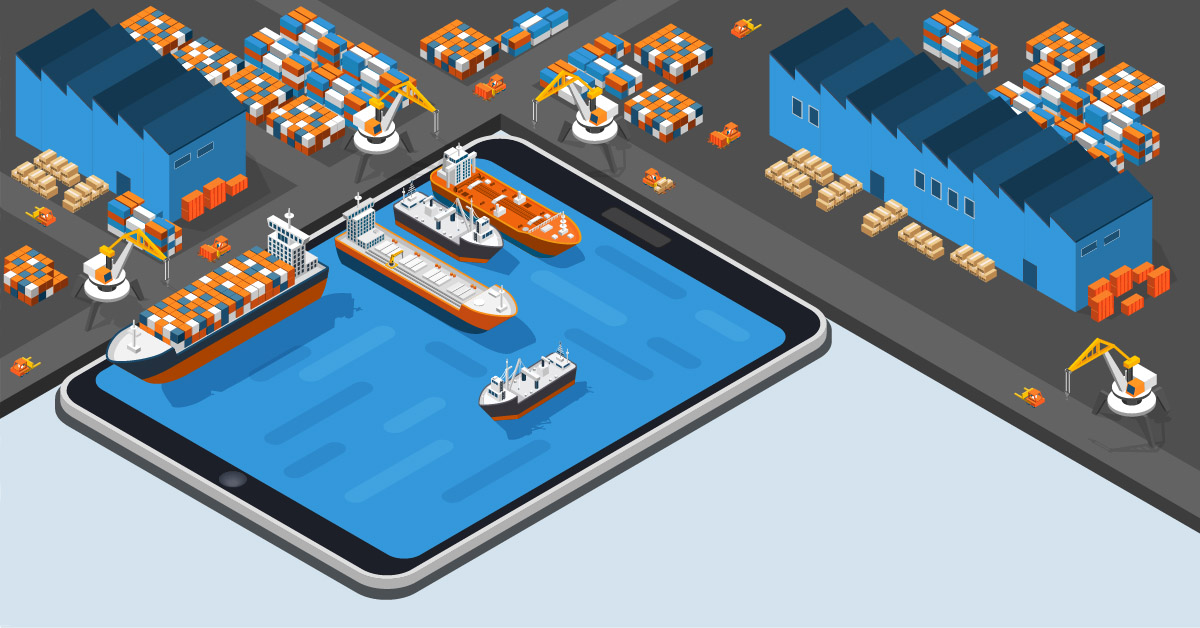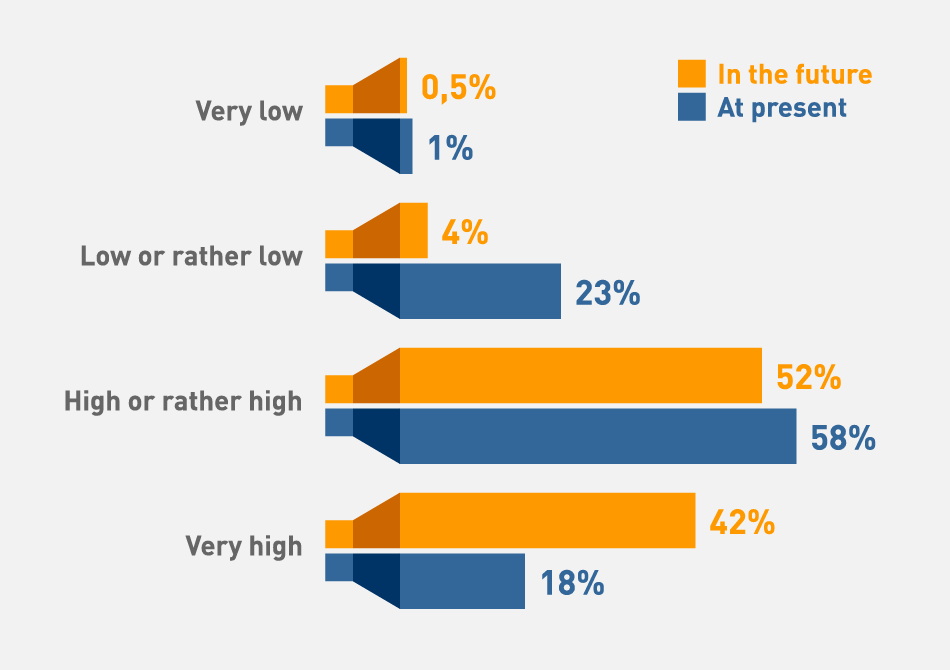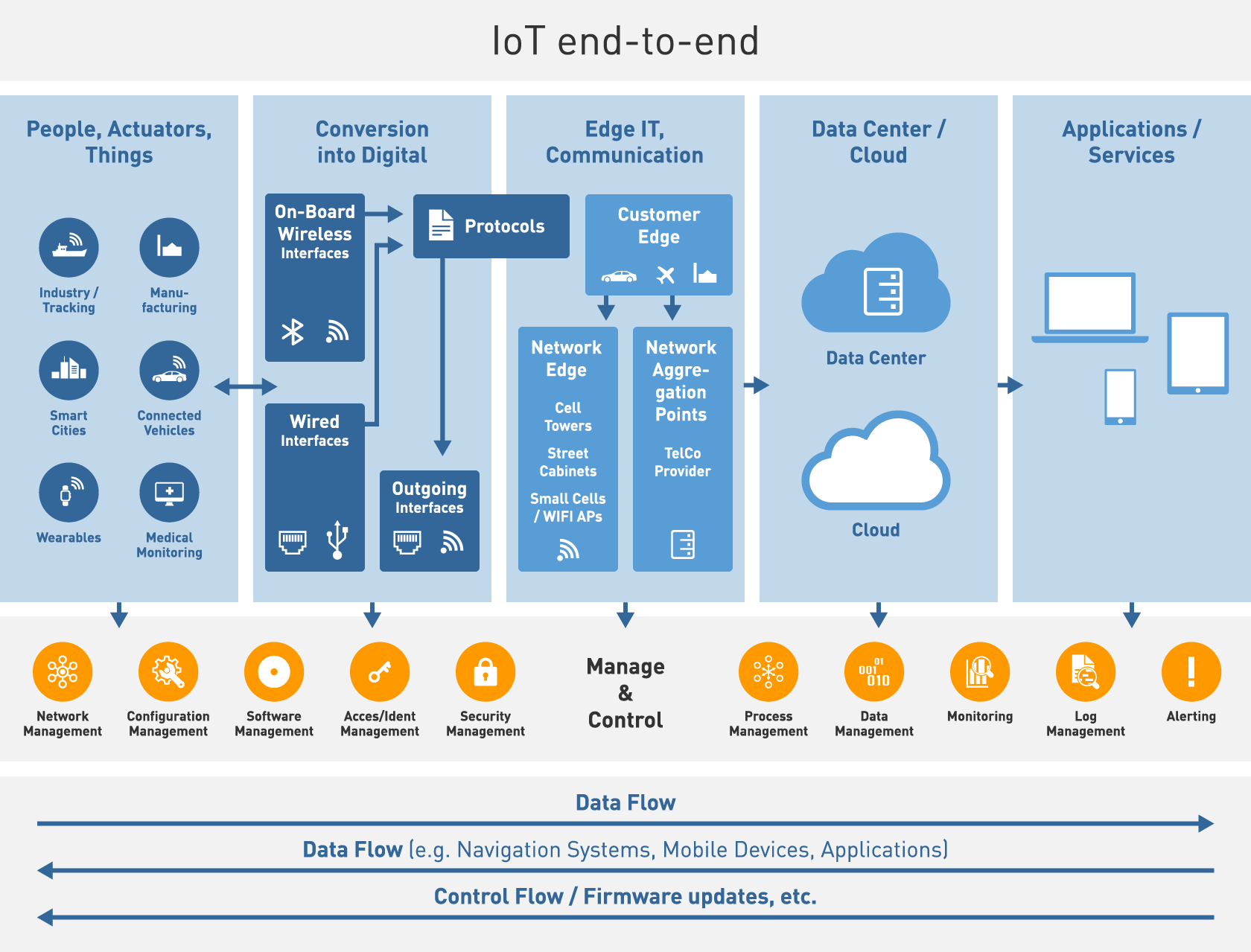
Internet of Things — The Disruption of the 21st Century
If we are to believe a McKinsey study from 2016, the Internet of Things (IoT) will trigger a veritable economic boom by joining together billions of devices.
The McKinsey study forecasts that the economic value added annually by this technological leap forward will add up globally to somewhere between 3.9 and 11.1 trillion dollars as for 2025. The top end of that range would equate to a tenth of the world’s total economic output, which the World Bank says will reach nearly 100 trillion dollars in the next eight years. But even if this estimate should prove to be too high, the IoT projects that have already begun do give us an inkling of just how massively the entire economy is going to change. Companies should make sure they understand this technological leap, and start preparing for it.
Of Smart Ships and Containers — The Completely Networked Harbor
Just what benefits IoT could bring with it can be seen particularly well, for instance, in large ports. Here, a lot of money is lost every day when ships cannot take their berth when they want to, when unloading is delayed or if containers end up on the wrong truck. In order to prevent such problems, Rotterdam has launched an extensive digitization project for its port. This gigantic hub, where 140,000 ships are processed every year, is being interconnected from the ground up in collaboration with the US company IBM. Sensors are being installed all over, measuring tides, temperatures, the wind, … The berths report when they are vacant and every ship looking to come into the harbor automatically announces this intention hours in advance. The old radio and radar communication between captains and tugboats is becoming obsolete — everything dovetails.
And the Hamburg port authority is pursuing very similar projects together with the network provider Nokia. It wants all containers to be fitted with radio chips in the future, so that their contents and temperature can be constantly monitored and controlled. If one of the many thousands of containers on a ship is wrongfully opened, or if the refrigeration system breaks down, the system immediately sounds the alarm. In this way, the enormous port monitors and controls itself down to the last detail. It will become increasingly unnecessary for port workers to be involved, especially as large ships will probably steer themselves autonomously in a few years. If we set aside questions of economic ethics, digitization will help port operators significantly improve their efficiency levels.
How do you rate the relevance of Internet of Things?

And it looks as though there are big changes on the horizon not only in the field of logistics, but also in many other industries. Most companies think that the Internet of Things will be as important as this study suggests. Hardly anyone denies anymore that IoT is important. More than 75% of those surveyed said that they estimate the importance at the moment to be either high or very high, and over 95% thought the same for the future (the study asked about the next 2–3 years). So most companies have recognized the trend; now they have to start preparing themselves for the technological paradigm shift.
Predictive Maintenance – When Machines Look After Themselves
The analog world sometimes works well, and sometimes not so well. From time to time a gasket breaks, a cable melts or a pipe gets blocked. And a lot of time can pass until a technician has been contacted, the problem located and the broken part replaced. This is especially critical for companies if the issue leads to other processes being compromised as well. In future, a smart system networked through the IoT will make sure that breakdowns don’t even happen in the first place. Sensors will be installed at key places in machines, elevators and conveyor belts that constantly gather data about the operating status, environmental conditions or wear and tear on individual components. Special software solutions are capable of evaluating this data and recognizing the threat of a malfunction before it happens, on the basis of predefined threshold values for each component. In this way, the system can automatically trigger a maintenance intervention by, for instance, calling a technician and sending him all the information he or she needs to know, before even coming to the machine.
Many large companies are already in the process of implementing this kind of system, including Thyssen Krupp Elevator. It is networking more than 100,000 elevators and escalators using the Microsoft Cloud system Azure. Deutsche Bahn is also working on the Internet of Things. For instance, with predictive maintenance, it aims to prevent things like broken wheels that cause train crashes, as was the case in the ICE accident in Eschede in 1998 that killed 101 people.
Cities and other local government bodies are also showing interest in the Internet of Things, hoping to improve how their citizens are tended to, while at the same time improving efficiency. Suppliers of large company groups and administrations should know their IoT strategies, so that they can adapt to them and possibly offer their own solutions. Another good reason is to improve one’s own processes. There are many reasons to implement the IoT, but the four most commonly mentioned are:
Why do you use IoT in your company?

Striped Giraffe helps you analyze use cases relevant for your enterprise, identifies potential originators of relevant data and develops together with you the demands on the value-generating applications.
The direct path to the customer — IoT in the trade
The Internet of Things could trigger a kind of counterrevolution in the retail trade. While a good portion of sales have migrated to the internet in recent years, the IoT could now help make the customer experience in brick-and-mortar stores more attractive again. There are a lot of ideas on the table for how to do so. One option is having customers recognized on the basis of their mobile phone when they enter the store and pointing them to products that they previously researched online. Or customers could get personal special offers sent to their phone. Products bought could be paid for automatically when leaving the store by means of chips on the product packaging and Near Field Communication (NFC). This technology is still too expensive to use on low-price bulk goods, but NFC chips can already today be used profitably on more expensive products, because they mean that the store requires less personnel. Management consultancy McKinsey believes that this kind of technology enables significant increases in efficiency to be achieved, and there are even more benefits for warehouse, inventory and automatic order management. Dwindling stocks on shelves could trigger an automatic reorder process using the IoT. All vendors will have to consider whether they want to start using IoT technology in the coming years if they wish to remain competitive. At Striped Giraffe, we see ourselves as service providers who help make such decisions and implement the required changes.
Language Issues and Data Speed – Not Even the Big Hurdles Will Stop the IoT
The Internet of Things’ big problem at the moment is that the existing technologies don’t mesh perfectly yet because of a lack of uniform standards. Smart machines, networked shelves and automatic cash-register systems are mostly still insular. There is often no communication between the individual technologies unless the various systems happen to come from the same manufacturer. But it is just this total networking that is essential for companies to really be smart in the future.
But there are serious initiatives driving mutual standards forward in order to make an unlimited flow of data possible. Just this kind of foundation for the Internet of Things is currently being created with the Eebus standard, which more than 70 enterprises and associations from various industries are working on (including IBM, Intel, e.on, Deutsche Telekom, Miele, …). The idea behind Eebus is to create a kind of minimum networking norm for the key communication requirements that guarantee the safe use of energy, for example in e-cars. Eebus has already opened up for companies that are not part of the development group. And other branches of the economy now have to come up with similar solutions, ideally ones that work across industries as well.
The second biggest obstacle to a large-scale Internet of Things is a high-performance data network. Telecom enterprises around the world are currently working on the new 5G network. It is said that it will offer 100 times the data speed in mobile telephony that is possible today. And reaction times are to be far shorter too. But before that can happen, an entirely new infrastructure with transmission masts and switching technology has to be built up for 5G. So this new network technology won’t be launched until at least 2020, and another five to ten years will pass before it is available to everybody, say the various forecasts. Parallel to it, network providers are developing a transitional technology known as the Narrowband IoT (NB IoT). This technology is suited to networking less “data-hungry” devices such as movement sensors and electricity meters. Its benefit is its low level of energy consumption, which means that it may ultimately end up being far more than just a temporary bridging technology. And what is more, this radio technology easily penetrates most buildings, so companies don’t necessarily have to wait for 5G in order to start initiating successful IoT projects already today.
At Striped Giraffe, it is our opinion that data generated by IoT shouldn’t be sent through the internet unless it says something relevant anyway. A machine that is constantly sending out the message from each sensor on each and every one of its components that “I’m doing just fine” is only causing unnecessary traffic jamming up the data highways.
Build and Secure — The IoT is a Herculean Task for Companies

Accomplishing effective networking is a big challenge, because the infrastructure in companies is normally not set up for it. In many cases, even the source files are lacking, such as machine downtime logs. The IT is only IoT-ready in the fewest of companies. Many CIOs are very self-critical though, and openly admit in surveys that their systems aren’t prepared for a transition.
On top of this come whole new challenges in the fields of IT security and data protection. Every device that is connected up to the internet is a potential leak that needs plugging. Embedded systems are the biggest problems here, as they often have striking security issues. The development of embedded systems has not been focused on IT security to date. After all, coffee machines, vacuum cleaners, cordless drills and conveyor belts only had to run themselves; there was no external access to them. If they were now to be connected up to the Web without making the necessary technical modifications, they would present hackers with an easy-to-use platform for their mischief. Surveillance cameras, for instance, are a very popular target for criminals. So, in addition to building up an IoT, enterprises also have to develop a strong awareness for IT security and defense mechanisms to deal with attacks that could potentially cripple their entire organization.
Most companies aren’t executing their IoT projects on their own. 75% of the people surveyed in a study by the market researcher CIO said they were working together with external experts in this context. These companies seek advice in particular on how to develop and design IoT solutions, on security matters, when putting together the business case and in the implementation.
Here, Striped Giraffe is a tried-and-trusted partner across the entire IoT value chain. We stand by our clients from the design and architecture of their IoT solution, all the way through to questions of security and the practical implementation.
Telekom, Microsoft and Many More – The Platform Jungle
Ever more providers are attempting to get into the rapidly growing IoT field of business. Numerous platforms have emerged, most of which are backed by major company groups. But they all have their own focuses that depend on their respective core field of expertise.
Even as a private customer of Deutsche Telekom, you now regularly receive advertising about IoT applications. The former monopolist on the German telecommunications market is of course first and foremost a network provider, but it also has a lot of know-how as a Cloud operator. The new embedded SIMs (which are gradually replacing the traditional SIM cards in mobile telephony) are an important new component for IoT solutions. The Telekom product range also boasts platforms for collecting, evaluating and visualizing machine-sensor data in companies. The company group is currently in the process of introducing a Narrowband IoT in Europe, so that it can start offering smart-home products.
In its capacity as a Cloud provider, Microsoft is trying to connect its Azure product with partners, in order to be able to offer IoT solutions in as many industries as possible. There is a catalog of around 200 devices from approx. 100 partners that are certified for use with the Azure IoT suite. Microsoft’s focus in the field of IoT development is on the maintenance and repair of elevators and escalators, for instance, and on everything to do with the evaluation of data at suppliers and service providers (insurance companies) with regard to connected cars. Microsoft’s services can also be ordered in a purely German Cloud.
The network equipment vendor Cisco has taken over the platform operator Jasper Technologies, and it now offers the Cisco Jasper Control Center as an SaaS solution for IoT projects. Jasper can be joined up to nearly all mobile networks in the world, making it useful for connected-car concepts, networked factories and smart energy provision. It claims to already have 85 million devices and 17,000 companies interconnected via the platform (June 2018). Pillars of the Cisco IoT system are network connectivity, fog computing, data analytics, security, management and automation, and the application platform.
As a Cloud operator and trading company, Amazon offers the internet platform AWS IoT, through which the joined devices can work together with Cloud applications and other devices. Services include AWS Lambda (data processing), Amazon Kinesis (Cloud platform for data streaming), Amazon S3 (Cloud memory) and Amazon Machine Learning. The range of services encompasses the collection of the data from connected devices, the processing and analysis of those data, and its preparation for other activities. Users of machine learning can apply specific algorithms to recognize patterns in data, develop forecasting models with them and, where applicable, make preventative modifications. Amazon also has retail concepts in its portfolio through its subsidiary 2lemetry.
The cornerstone of IBM’s IoT strategy is the supercomputer program Watson, which is based in Munich, Germany. It is said that around 1,000 experts from IBM collaborate with partners and clients in the Bavarian state capital on this product. The key IoT applications it offers are analytics (e.g. with Watson Machine Learning and Watson Image and Video Analytics), Connect (connecting and managing devices), information management, risk and security management and the analysis of weather data. Furthermore, the IoT zone IBM Bluemix also offers developers the opportunity to program solutions together and to collect and evaluate data from IoT sources.
Google showed its ambitions with the Internet of Things early on in the piece by buying out the smart home and heating specialist Nest. Among the IoT concepts from Google are the communication platform Wave and the Android operating system “Things”, which supports processors and connectivity standards and is tailored to IoT applications. Google is extremely active in the field of artificial intelligence (AI), something that will become ever more important in the future for managing large and complex machine fleets and company networks. Google offers, for example, the database system BigQuery for data analysis, and the application platform Firebase for company solutions.
The IoT providers we have listed here are just a small selection from the numerous companies and co-operations that are already active in the Internet of Things. It can be assumed that many platforms will join forces in the near future, while others will not survive, making the market far less complex. For (corporate) clients, this could then become a problem if they have already decided to go with a technology that then disappears from the face of the Earth, along with its company.
We at Striped Giraffe put our trust in the market leader in the field of IoT platforms – a Java-based framework that you can take with you into any Cloud, tomorrow as today. This means our customers remain flexible and ready for all possible futures.

